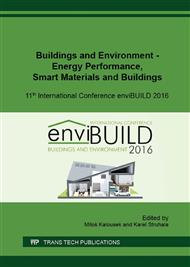[1]
D. Kakogiannis, F. Pascualena, B. Reymen, L. Pyl, J.M. Ndambi, E. Segers, D. Lecompte, J. Vantomme, T. Krauthammer, Blast performance of reinforced concrete hollow core slabs in combination with fire: Numerical and experimental assessment, Fire Safety J. 57 (2013).
DOI: 10.1016/j.firesaf.2012.10.027
Google Scholar
[2]
I. Venanzi, M. Breccolotti, A. D'Alessandro, A.L. Materazzi, Fire performance assessment of HPLWC hollow core slabs through full-scale furnace testing, Fire Safety J. 69 (2014) p.12–22.
DOI: 10.1016/j.firesaf.2014.07.004
Google Scholar
[3]
T.T. Nguyen, K.H. Tan, I.W. Burgess, Behaviour of composite slab-beam systems at elevated temperatures: Experimental and numerical investigation, Eng. Struct. 82 (2015) p.199–213.
DOI: 10.1016/j.engstruct.2014.10.044
Google Scholar
[4]
A.M. Shakya, V.K.R. Kodur, Response of precast prestressed concrete hollowcore slabs under fire conditions, Eng. Struct. 87 (2015) p.126–138.
DOI: 10.1016/j.engstruct.2015.01.018
Google Scholar
[5]
L. Lausova, I. Skotnicova, V. Michalcova, Thermal transient analysis of steel hollow sections exposed to fire, Per. Sci. 7 (2016) p.247—252.
DOI: 10.1016/j.pisc.2015.11.040
Google Scholar
[6]
J.V. Aguado, V. Albero, A. Espinos, A. Hospitaler, M.L. Romero, A 3D finite element model for predicting the fire behavior of hollow-core slabs, Eng. Struct. 108 (2016) p.12–27.
DOI: 10.1016/j.engstruct.2015.11.008
Google Scholar
[7]
G.L. Balázs, É. Lubloy, Fire resistance for thin-webbed concrete and masonry elements, Application of Structural Fire Engineering: Proceedings of the International Conference in Dubrovnik, Dubrovnik, (2015).
DOI: 10.14311/asfe.2015.036
Google Scholar
[8]
ISO 834-1: 1999, Fire-resistance tests — Elements of building construction — Part 1: General requirements, ISO, Geneve, (1999).
Google Scholar
[9]
EN 1365-2: 2014 Fire resistance tests for loadbearing elements. Part 2: Floors and roofs, CEN, Brussels, (2014).
DOI: 10.3403/30271390
Google Scholar
[10]
COMSOL Multiphysics 5. 0 User's Manual, Stockholm, (2015).
Google Scholar
[11]
EN 1992-1-2: 2004 Eurocode 2: Design of concrete structures. Part 1-2: General rules. Structural fire design, CEN, Brussels, (2004).
Google Scholar
[12]
EN 1993-1-2: 2004 Eurocode 3: Design of steel structures. Part 1-2: Structural fire design, CEN, Brussels, (2004).
Google Scholar
[13]
EN 1996-1-2: 2004 Eurocode 6: Design of masonry structures. Part 1-2: General rules. Structural fire design, CEN, Brussels, (2004).
DOI: 10.3403/30116737
Google Scholar
[14]
EN 1745: 2012 Masonry and masonry products. Methods for determining thermal properties, CEN, Brussels, (2012).
Google Scholar


